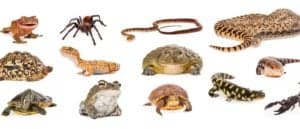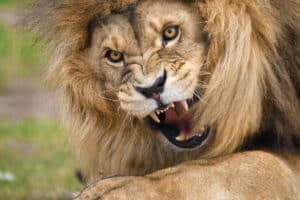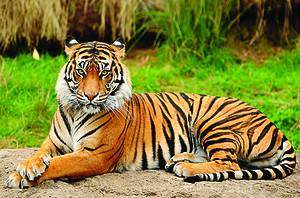Are you interested in owning an uncommon or exotic pet in England? Hold on a second! It’s crucial to know which animals you’re actually allowed to keep as pets. Some animals are illegal to keep because they could harm people, other animals, or even the local environment and ecosystem. Not knowing the law could land you in some serious legal hot water, including fines or worse.
In this article, we’re going to tell you about animals you might find fascinating but are actually illegal to own in England. It’s essential information for anyone pondering the idea of a non-traditional pet.
1. Egyptian Goose

If you’re thinking about getting an Egyptian goose as a pet, think again!
©LeonP/Shutterstock.com
Leading the list of illegal pets you can’t own in England is the Egyptian goose. This bird is native to Africa and belongs to the duck family.
Sporting a long neck, pink legs, a pink bill, and distinct brown eye patches, the Egyptian goose is easily identifiable. A unique brown patch on the chest further distinguishes it from other similar birds. The head and topside of the wings are also brown, contrasting with the lighter brown covering the rest of its body.
With a height range of 25 to 29 inches, they’re fairly large birds. Their diet is mostly plant-based but includes small mammals, insects that live in water, and aquatic plants as well.
Why It’s an Illegal Pet
The bird’s quick adaptability and territorial behavior have made it unwelcome in places like Britain and other European countries. They can breed with other species of geese and ducks, often taking over food sources and nesting areas from native wildlife. If they become overpopulated, their presence can lead to the depletion of local plant life, water pollution, and the transmission of diseases.
2. Pit Bull Terrier
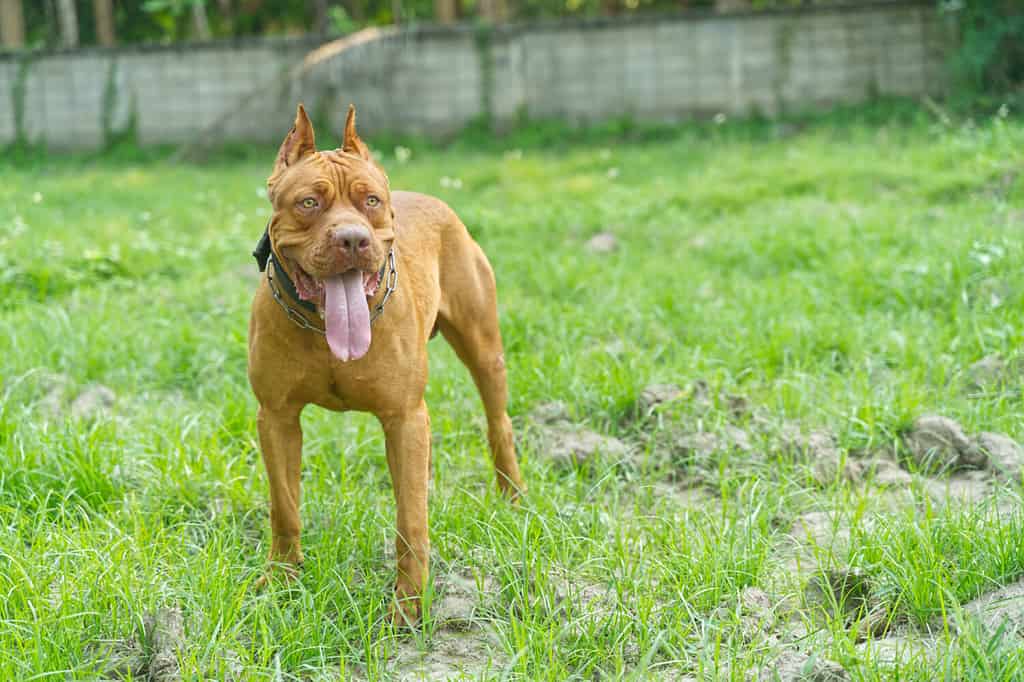
A surprising pet that is illegal to own in England is the pit
bull terrier
.
©KruBeer Photo/Shutterstock.com
Another pet that’s off limits in England is the pit bull terrier.
The pit bull’s ears are either small or medium and sit high on the head; they may or may not be clipped. Its eyes are set apart and medium-sized, and while breeders favor all colors, blue is generally avoided. The nose is broad and flat, coming in red, blue, or black shades.
Usually standing between 17 and 21 inches tall, these dogs aren’t strictly meat-eaters; they also consume plant-based foods.
Why It’s an Illegal Pet
The UK government banned pit bulls in 1991 through the Dangerous Dogs Act, following a series of deadly attacks on people between 1981 and 1991. These dogs are considered high-risk because they were initially bred for fighting.
They’re often seen as overly territorial and possessive, traits that make them potentially dangerous. They’ve gained a reputation for being unpredictable, even towards their owners.
3. Common Myna
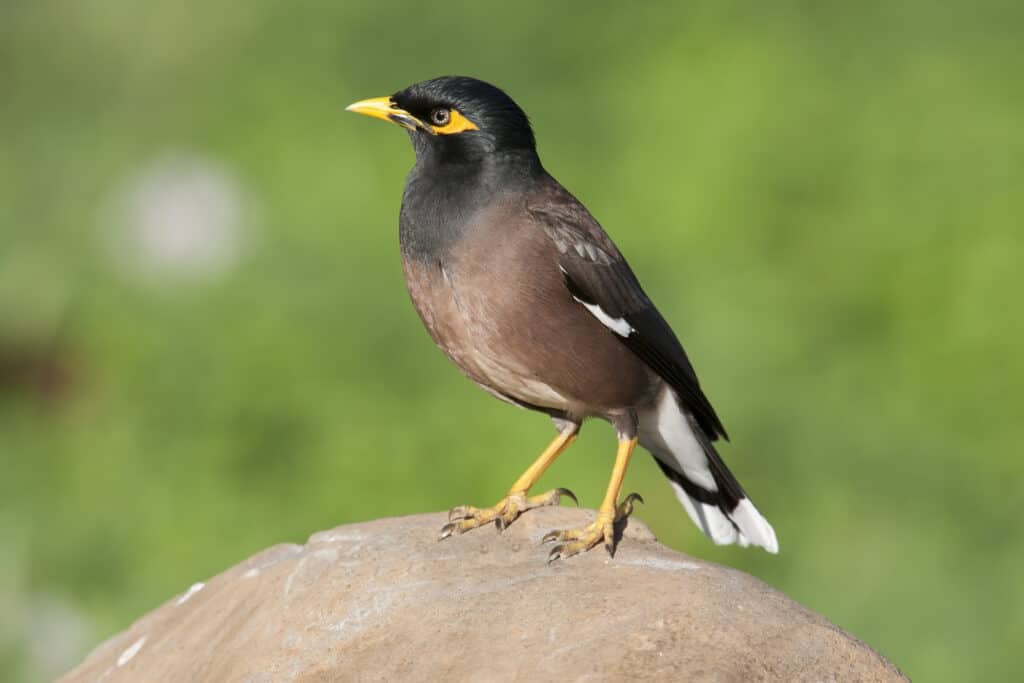
While the common myna is cute, it is illegal to own in England.
©Stubblefield Photography/Shutterstock.com
Originally from southern Asia, the common myna has been sold worldwide as a pet.
With a brown body and black head, the common myna has a yellow bill, legs, and skin around its eyes. When it flies, you can spot large white patches on its wings. It belongs to the starling family and is roughly 9 to 10 inches long, making it a bit smaller than a dove.
Known for their scavenging skills, common mynas eat just about anything — from bugs and fruits to leftover food and even young sparrows.
Why It’s an Illegal Pet
These birds are on the list of the world’s most harmful invasive species. They disrupt local ecosystems and outcompete native birds for resources. They’ve become a global issue and are one of only three bird species listed by the IUCN as among the ‘100 of the World’s Worst Invasive Alien Species.’
4. Pallas’ Squirrel
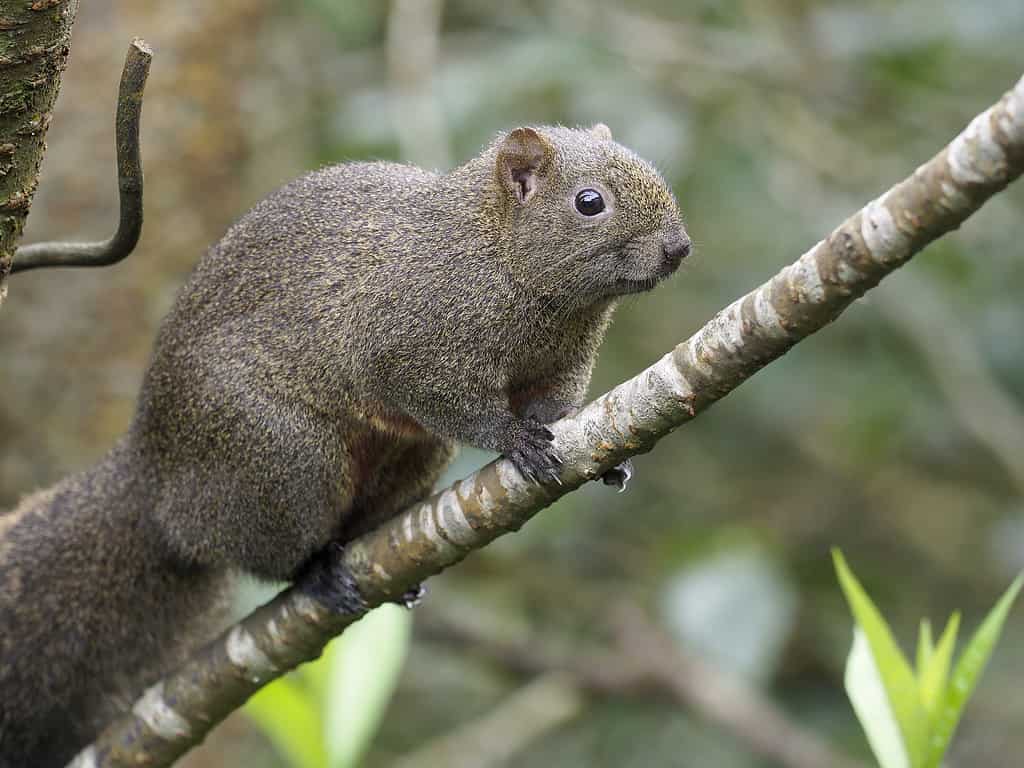
The Pallas’s squirrel is an invasive species in Europe.
©MikeLane45/iStock via Getty Images
Native to places like Greater China, India, and Southeast Asia, the Pallas’s squirrel is highly adaptable.
Coming in different colors depending on the region, it generally sports an olive-brown upper body with a reddish belly. These medium-sized squirrels have a length that varies between 6.3 and 11 inches.
These rodents aren’t picky eaters, consuming everything from tree seeds and plant parts like flowers and fruits to fungi and insects.
Why It’s an Illegal Pet
The European Union has already restricted the import of this species due to its invasive nature. Being on the Union’s list of Invasive Alien Species ensures more focused efforts to curb its spread.
What makes the pallas’ squirrel especially problematic as an invasive species is its adaptability and broad diet. It can feed on a variety of things, from bugs to nuts. Starting with just a few squirrels, feral populations can quickly grow, out-competing and sometimes even wiping out native red squirrels.
5. Indian House Crow

The Indian house crow is an illegal pet in England.
©Bebedi/iStock via Getty Images
You’re not allowed to own an Indian house crow in England, a bird originally from regions like India, the Middle East, and parts of Asia.
When it comes to size, it measures about 16 inches in length, falling between a jackdaw and a carrion crow but with a slimmer build. It has a glossy black color on its head and upper chest, while the neck and lower chest sport a lighter gray-brown. Its wings, tail, and legs are all black.
This crow will eat pretty much anything. From garbage and leftover food to small animals like lizards and fish, its diet is highly varied.
Why It’s an Illegal Pet
Highly intelligent, the Indian house crow tends to stick close to human areas, foraging through our waste and garbage dumps. This behavior makes it a potential health risk to people. Moreover, it poses a threat to local wildlife and crops because it preys on other birds and small mammals.
6. Small Asian Mongoose

The small Asian mongoose has a slim body and short limbs.
©Ninaada Bellippady/iStock via Getty Images
In England, owning a small Asian mongoose as a pet is illegal. This little mammal originally hails from Iraq and northern South Asia.
The creature is weasel-like in its physique, featuring a slim body and short limbs. A tail that forms nearly 40% of its body length adds to its unique look. With a slender head, pointed nose, and stubby ears, it’s easily identifiable. The fur is a mix of brown and gold, with the belly area being lighter in shade.
Adult individuals measure anywhere from 9 to 25 inches.
It’s a versatile eater, primarily feasting on insects but also open to munching on other small critters like scorpions and crabs. Even snakes aren’t off the menu. In addition, it enjoys fruits, seeds, and nuts.
Why It’s an Illegal Pet
Introduced to new regions, this mongoose often becomes a menace to local wildlife. Many indigenous animals are not adapted to deal with such a predatory presence, making them particularly susceptible.
Its negative impact on ecosystems has earned it a spot on the International Union for Conservation of Nature’s list of the world’s top 100 invasive species.
7. Japanese Tosa

The Japanese tosa is another pet that is illegal to own in England.
©TMArt/Shutterstock.com
Another dog that you can’t own as a pet in England is the Japanese tosa.
This dog has a large black nose that matches the size of its muzzle. It possesses strong jaws with big teeth that meet in a scissors-like bite. The eyes are relatively small and dark brown, set into a head that’s notably large. The neck is heavily muscled and includes loose, hanging skin.
These dogs can stand anywhere between 24 and 32 inches tall at the shoulder. Like most dogs, they have a diet that includes both meat and plants.
Why It’s an Illegal Pet
Originally bred for dog fighting, the Japanese tosa is prohibited in the UK even though there have been very few of them in the country. They are sizable canines with formidable jaws. Their temperament can be risky, making them potentially lethal. Due to their large size, they pose a particular risk to small children.
8. Pumpkinseed
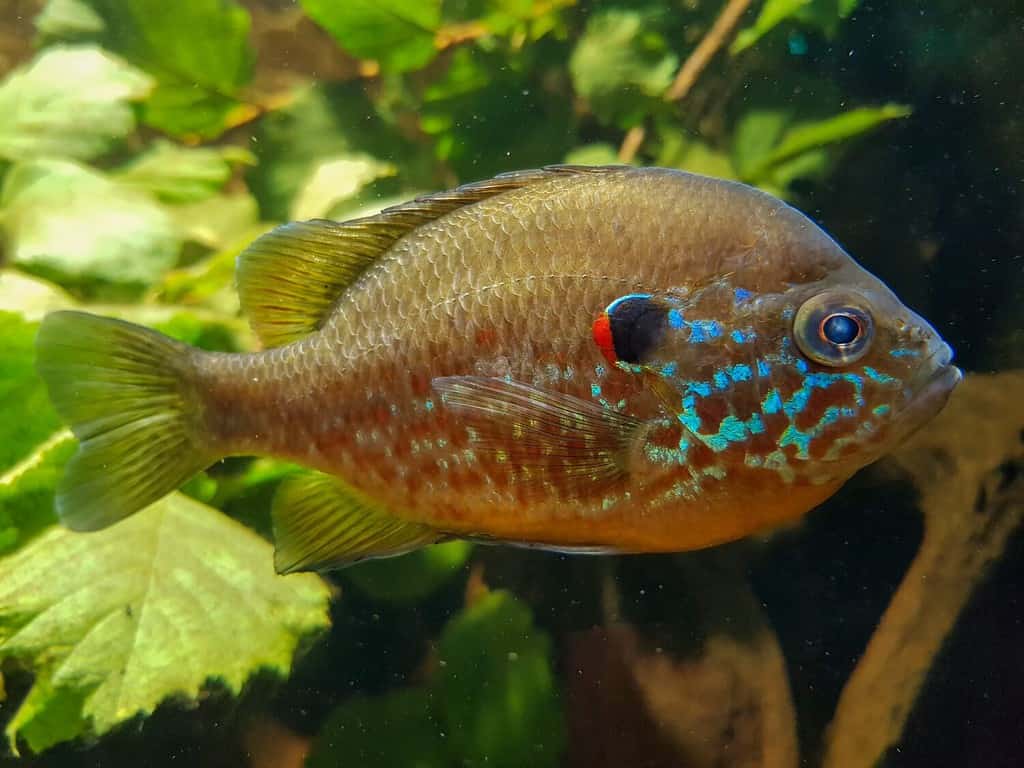
The pumpkinseed fish is detrimental to local ecosystems.
©Fabian Junge/Shutterstock.com
In England, it’s illegal to own a pumpkinseed fish, a species originally found in North American freshwater bodies.
This vibrant fish features an orange underbelly, black ear covers framed with eye-catching red or orange edges, and a slightly split tail fin with smooth edges. The top fin boasts around 10 spines. Typically, they measure between 4 to 6 inches but can reach up to a foot.
These fish eat a wide range of small living things, from snails and worms to tiny fish and even plant material.
Why It’s an Illegal Pet
Introduced to European waters about a century ago, pumpkinseeds have proven detrimental to local ecosystems in places like England. They’re so successful at adapting that they often edge out local fish species.
One of the big issues is their high reproductive rate, which leads to fast-growing populations that throw native ecosystems out of balance. They even feed on the eggs and young of other aquatic species, making their impact even more devastating.
9. American Bullfrog
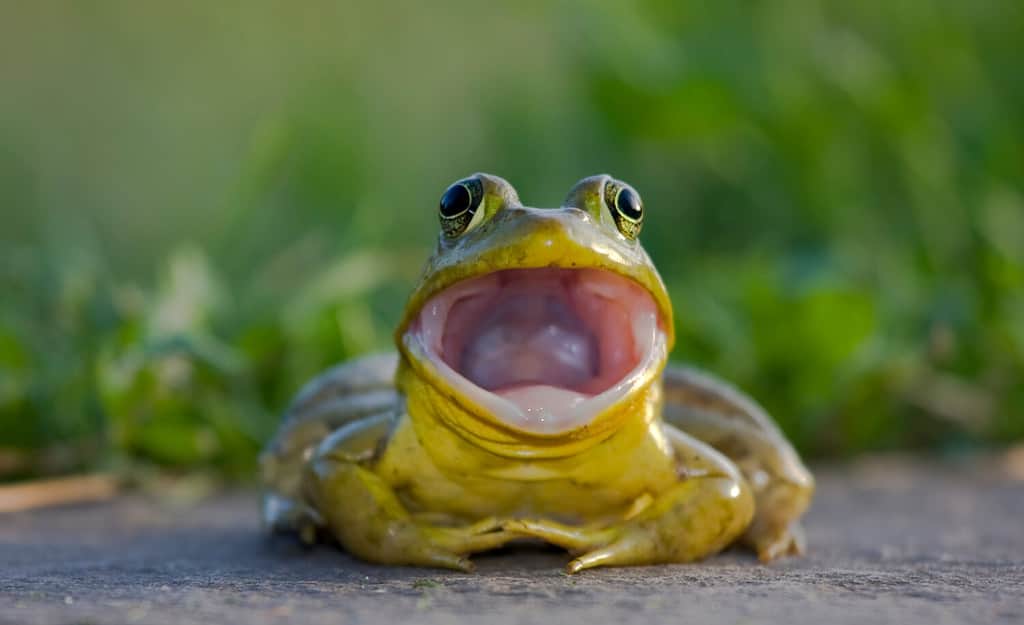
The American bullfrog can risk native wildlife in England.
©Tau5/Shutterstock.com
Owning an American bullfrog as a pet in England is against the law.
These large frogs display a variety of green colors and can have spots on their limbs and back. Their underbellies are generally white and may also have some spotting. They hold the record for being North America’s largest frog, with some reaching a size of 8 inches.
Why It’s an Illegal Pet
These frogs pose a serious risk to native wildlife in England. They outsize local frogs and won’t hesitate to eat them or other animals of a similar size.
What makes them particularly troublesome is their predatory nature, especially since they don’t have any natural enemies in the UK to control their population. Their presence negatively affects native species by both consuming them and outcompeting them for food and other resources.
10. Coypu
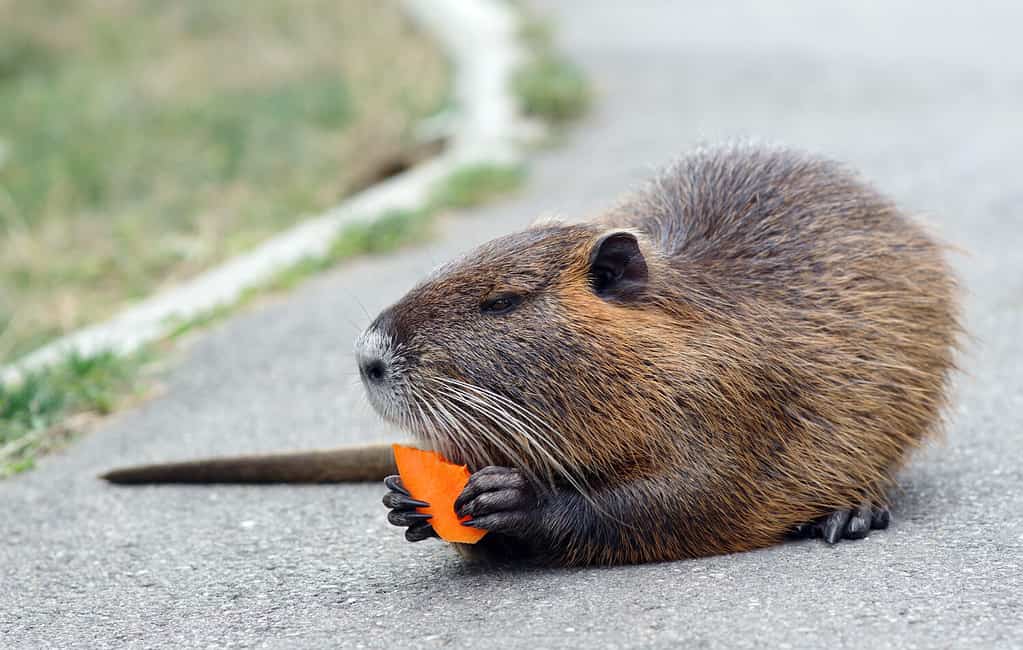
The coypu is also called the nutria.
©KRIACHKO OLEKSII/Shutterstock.com
The coypu, sometimes called a nutria or river rat, is a chunky, water-dwelling rodent.
This rodent sports a curved back and a large head that’s almost shaped like a triangle. Its tiny ears and eyes are set high on its head, and it has orange-tinged, wide front teeth. An adult coypu typically measures from 16 to 25 inches long.
As for diet, these rodents mostly feed on plant matter, particularly fond of aquatic plants like cattails, reeds, and sedges.
Why It’s an Illegal Pet
Not only do they harm the environment, but coypus also pose a risk to agriculture and health by eating crops and potentially transmitting diseases to other animals and humans. They’re especially problematic because they consume about 25% of their body weight in food daily and are active all year.
The UK successfully eliminated these rodents from the wild by 1989, an effort that started back in 1981. The total expense for eradicating them amounted to a hefty £2.5 million. There have been no confirmed coypu sightings in England since.
11. Coati
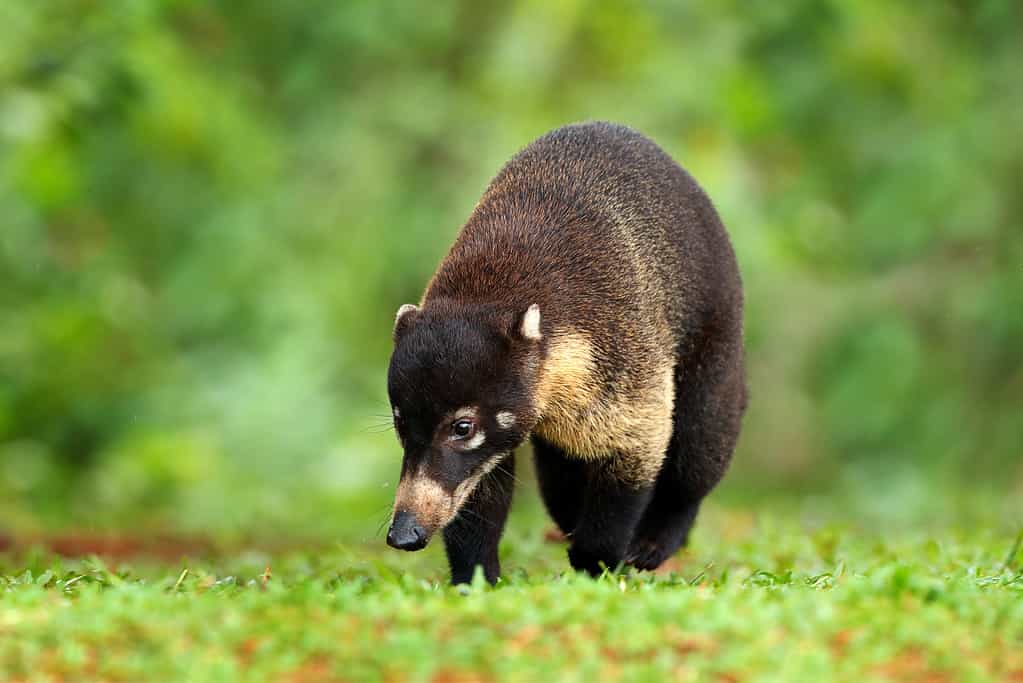
Native to the Americas, coatis are illegal to own as pets in England.
©Ondrej Prosicky/Shutterstock.com
Coatis are native to the Americas and typically live in humid or tropical forests. They have a bendy nose and a thin tail with dark stripes, which they usually hold up while walking. Their fur ranges from gray to brown or reddish shades, and their face has lighter markings. Standing about 12 inches high, they’re not very tall animals.
Their diet is diverse, including fruits, bugs, tiny mammals, and lizards. They search for their meals both on the ground and sometimes in trees.
Why It’s an Illegal Pet
Because they’ll eat almost anything, coatis can seriously harm local endangered animals. They also pose risks to farming by potentially damaging crops and spreading diseases to both livestock and humans.
12. Raccoon Dog
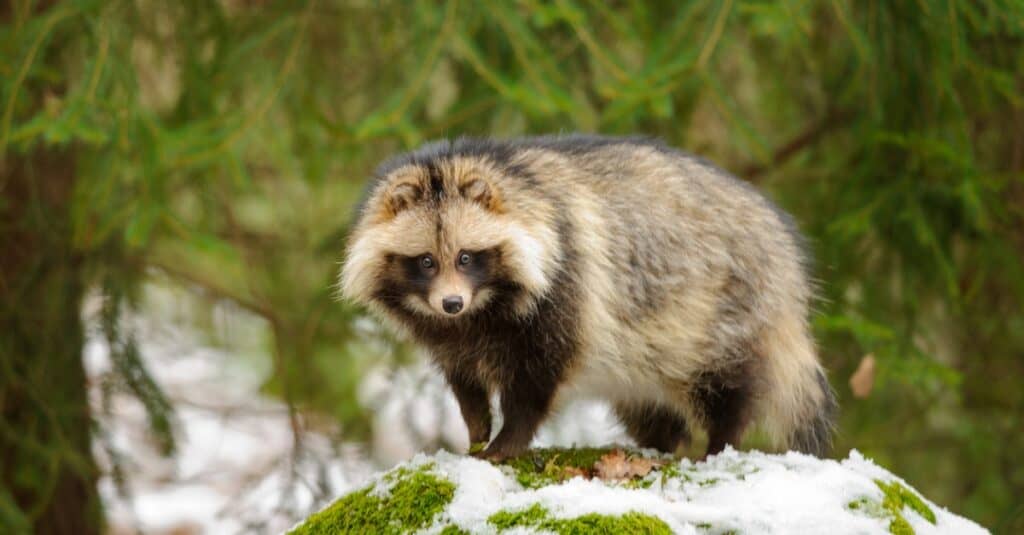
Although they may look similar, the raccoon dog is not a raccoon.
©iStock.com/sduben
The raccoon dog is a small animal native to East Asia. It has two dark eyes and ears that look like a fox’s, yet its facial fur pattern, especially the black rings around its eyes, make it appear similar to a raccoon. These animals are usually between 18 and 26 inches long.
Their eating habits vary, ranging from insects and small animals to fish and even decaying matter. They’re also fond of fruits, nuts, and berries.
Why It’s an Illegal Pet
Animal specialists warn that the raccoon dog poses risks to England’s local wildlife, particularly endangering rare species of ground-nesting birds, amphibians, and small mammals. They’re also carriers for several types of diseases.
13. Muskrat
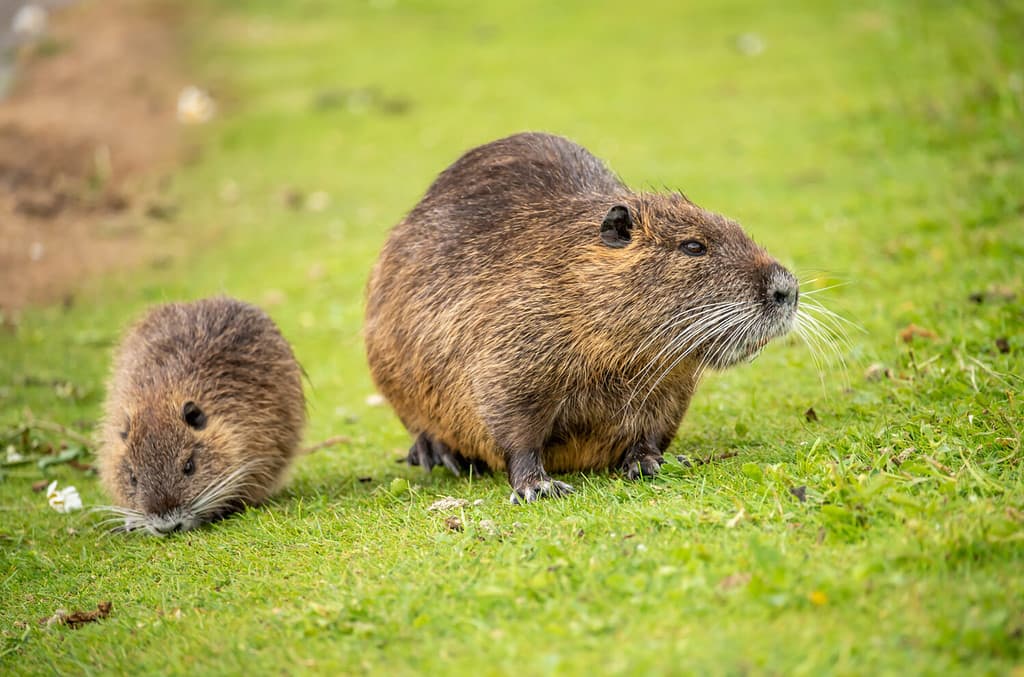
Another illegal rodent is the muskrat.
©Blende8/Shutterstock.com
The muskrat is a medium-sized rodent. Its sleek fur can range from almost black to a silvery-brown shade, with a lighter color on its throat and belly. The muskrat’s unique tail is flat and scaly, and it can be as long as 10 inches.
Mostly vegetarian, the muskrat eats plants but will switch to snails, shellfish, or frogs if plant food is scarce.
Why It’s an Illegal Pet
In the past, these rodents managed to establish a population in the UK. However, extensive efforts led to their complete removal, making them one of the rare foreign species to be successfully wiped out in Britain.
Muskrats can pose a health risk, carrying diseases like tularemia and Leptospirosis. These diseases can be transmitted to humans through contaminated water or direct contact with infected animal tissue.
14. Ruddy Duck

The ruddy duck can threaten white-headed duck populations.
©Ken Hoehn/iStock via Getty Images
Native to North America, the ruddy duck is a distinctive waterfowl with a stiff tail, often held upright. During breeding season, males stand out with their bright blue bills, white cheeks, and reddish-brown bodies. These ducks are usually between 13.5 to 17 inches long.
They have a varied diet, mainly eating aquatic plant seeds and roots, but they also consume aquatic insects and small crustaceans.
Why It’s an Illegal Pet
In Europe, the ruddy duck poses a risk to the white-headed duck, a species deemed vulnerable by conservation organizations. The ruddy duck can breed with the white-headed duck, creating hybrids that threaten the latter’s survival. Consequently, efforts are underway in England to eliminate the ruddy duck population to protect the native white-headed duck.
15. Signal Crayfish
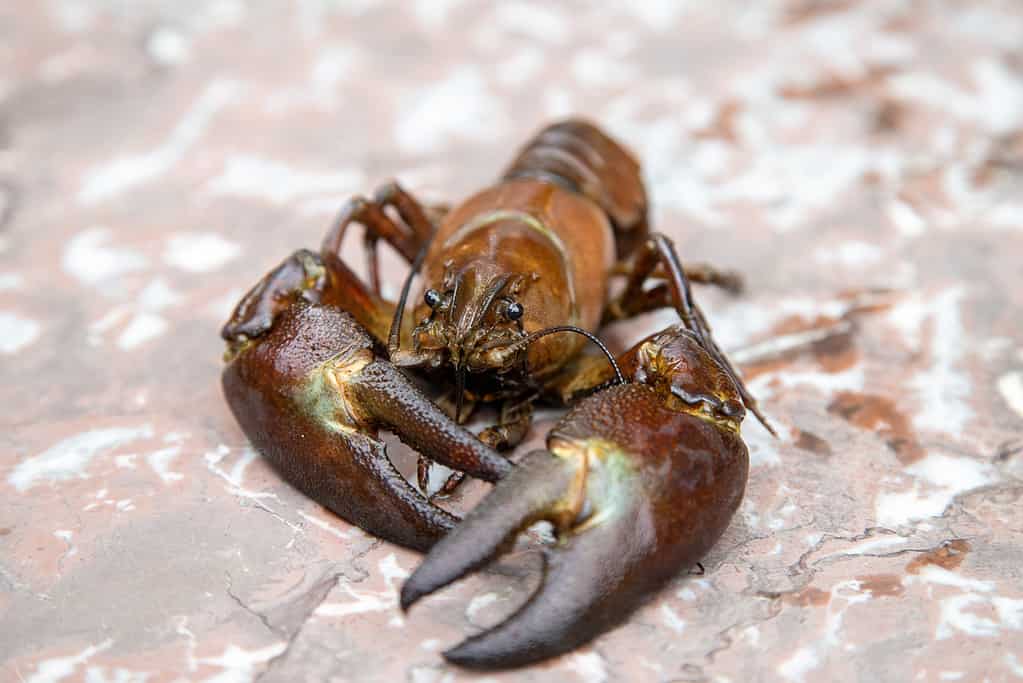
Another pet you cannot own in England is the signal crayfish.
©Reiner/iStock via Getty Images
The signal crayfish was introduced to Europe in the 1970s. These crayfish can be as long as 3 to 8 inches and resemble miniature lobsters. Their color is generally a mix of green and brown, but they have a vivid red underside as well as a red lower claw area, marked by a small bluish-white spot near the claw hinge.
In terms of diet, they mostly eat plants as adults but are known to eat other signal crayfish at times.
Why It’s an Illegal Pet
The species has been problematic both environmentally and economically. They are carriers of a disease known as crayfish plague, lethal to the local white-clawed crayfish. This disease is spread by spores in the water.
16. Striped Eel Catfish
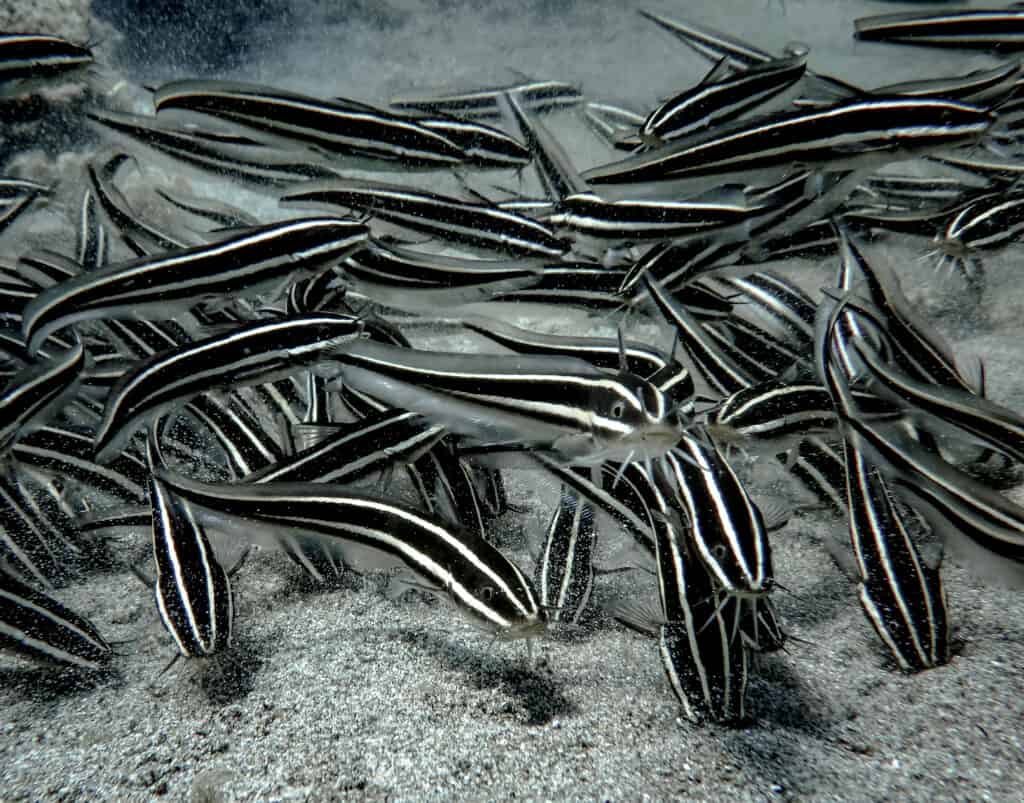
Unfortunately, striped eel
catfish
can be detrimental to the local environment.
©iStock.com/norman lopez
The striped eel catfish is the only catfish that lives in coral reefs. This fish has a long, cylindrical body that transitions into a tail like an eel’s. Its colors range from black and brown to even a dark maroon. It also has two or three stripes along its body. When fully grown, it can reach a length of 12.6 inches.
These catfish eat invertebrates that inhabit the ocean floor, such as small fish, worms, and crustaceans.
Why It’s an Illegal Pet
Unfortunately, striped eel catfish are not good news for the environment or safety reasons. They out-compete local sea creatures for food and living spaces and can also displace native predators. Adding to the concern, they carry venom, making them dangerous to animals and humans.
17. Siberian Chipmunk
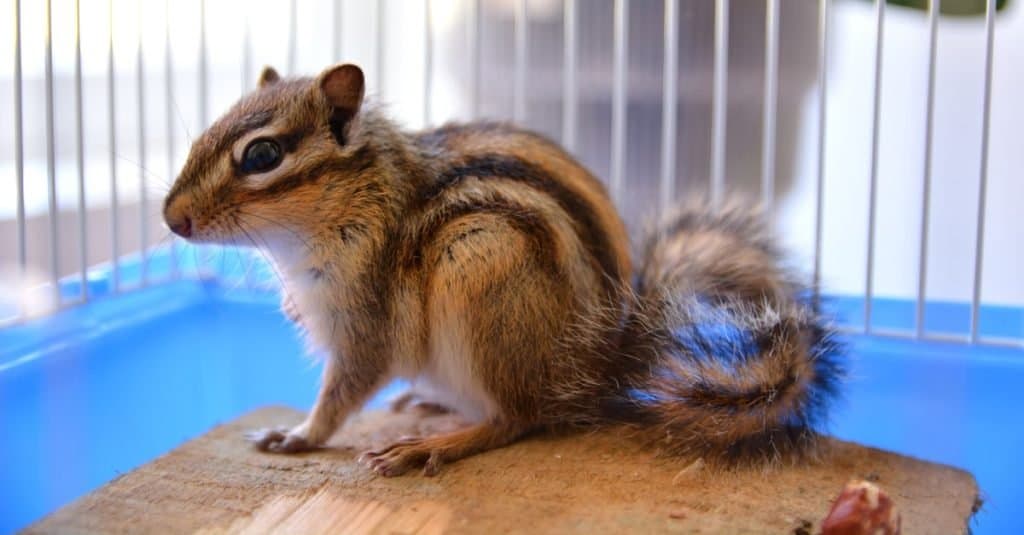
While they may be cute,
Siberian
chipmunks are illegal pets in England.
©Emmily/Shutterstock.com
The Siberian chipmunk has become a trendy choice for a pet despite its small size. This little rodent has a distinct look with five dark and four light stripes running down its back. Its fur ranges from a yellowish to a brown shade, while its chest and belly are white. This illegal pet measures 7.1 to 9.8 inches.
Siberian chipmunks feed on seeds, fruits, vegetables, and grains, as well as insects, small birds, and lizards.
Why It’s an Illegal Pet
Research indicates that these chipmunks may increase the risk of Lyme disease more than local rodents do, making them a public health concern. As of August 2016, the European Commission has listed the Siberian chipmunk as an invasive species. This means it’s now illegal to purchase or sell one in England.
Other Illegal Pets in England
Here are some other pets that you absolutely cannot own in England, and why:
Bears: Wild nature, potential threat to human safety.
Tasmanian Devil: Considered wild and potentially dangerous.
Big Cats: Wild nature, potential threat to human safety.
Alligators and Crocodiles: Potential threat to human safety.
Kangaroos: Their wild nature.
Giraffe: Size, wild nature, extensive care required.
Tigers: Dangerous nature, potential threat to human safety.
Certain Spider Breeds: Venomous nature, potential threat to human safety.
Badgers and other Mustelidae family animals: Their wild nature.
Hyenas: Wild nature, potential threat to humans and other animals.
Summary of Illegal Pets to Own in England
| Number | Pet | Scientific Name |
|---|---|---|
| 1. | Egyptian Goose | Alopochen aegyptiaca |
| 2. | Pitbull Terrier | Canis lupus familiaris |
| 3. | Common Myna | Acridotheres tristis |
| 4. | Pallas’ Squirrel | Callosciurus erythraeus |
| 5. | Indian House Crow | Corvus splendens |
| 6. | Small Asian Mongoose | Urva auropunctata |
| 7. | Japanse Tosa | Canis lupus familiaris |
| 8. | Pumpkinseed | Lepomis gibbosus |
| 9. | American Bullfrog | Lithobates catesbeianus |
| 10. | Coypu | Myocastor coypus |
| 11. | Coati | Nasua |
| 12. | Raccoon Dog | Nyctereutes procyonoides |
| 13. | Muskrat | Ondatra zibethicus |
| 14. | Ruddy Duck | Oxyura jamaicensis |
| 15. | Signal Crayfish | Pacifastacus leniusculus |
| 16. | Striped Eel Catfish | Plotosus lineatus |
| 17. | Siberian Chipmunk | Eutamias sibiricus |
The photo featured at the top of this post is © MikeLane45/iStock via Getty Images
Thank you for reading! Have some feedback for us? Contact the AZ Animals editorial team.



